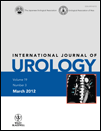Silodosin and its potential for treating premature ejaculation: A preliminary report
Abstract
Premature ejaculation is a common sexual problem, as is erectile dysfunction. We evaluated silodosin, a highly selective α1A-adrenoceptor antagonist, as a new treatment option for premature ejaculation. α1-Adrenoceptor antagonists are widely used for lower urinary tract symptoms, and clinical studies on silodosin have shown excellent clinical efficacy for lower urinary tract symptoms. However, compared with other α1-adrenoceptor antagonists, silodosin appeared to suppress ejaculation in a relatively higher percent of trial participants. This suppression of ejaculation by silodosin suggested its potential for treating premature ejaculation. Consequently, we evaluated the feasibility of off-label silodosin as a new treatment option for premature ejaculation. Eight patients suffering premature ejaculation were treated with silodosin. Silodosin (4 mg) was given 2 h before sexual intercourse. Intravaginal ejaculatory latency time, premature ejaculation profile item, clinical global impression change in premature ejaculation and systemic adverse events were recorded. Intravaginal ejaculatory latency time was significantly prolonged (from 3.4 min to 10.1 min, P = 0.003). All patients answered better (much better) or slightly better for their own premature ejaculation problem compared with pretreatment condition in the clinical global impression change. Premature ejaculation profile also significantly improved. Two (25%), three (37.5%) and seven patients (87.5%) experienced anejaculation, reduced semen volume and discomfort during orgasm, respectively. However, these problems were not of major concern for the participants. No systemic adverse effects were reported. The current results support the possible use of silodosin as a new treatment option for premature ejaculation, and suggest that a placebo controlled study assessing its clinical usefulness would be worthwhile.




